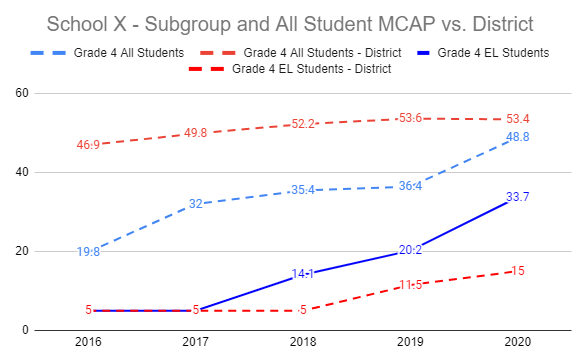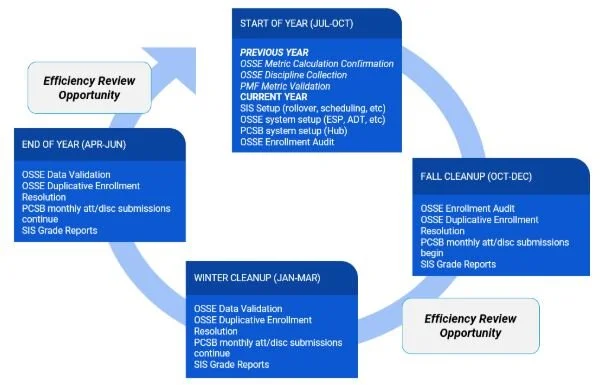It's budget season which means we are looking closely at costs for next year. If you are reeling from sticker shock after speaking to your vendor partners, take solace that you are not alone.
Read MoreOur student data team partnered with the Maryland Alliance of Public Charter Schools to develop a series of webinars and accompanying tools aimed at supporting school leaders in identifying and effectively communicating their school’s success story using data.
Read MorePlanning for how to address the COVID slide, or even a COVID slowdown, is challenging given the undefined path of the next few months, but one thing that is certain is that data will play a more critical role than ever in efficiently and effectively planning to make up for lost time and learning. The key questions many are looking to answer – which data to use, when to collect the data, and what to do with the data. While no consensus has been reached, a number of ideas and strategies are emerging that capture how schools plan to use current and future data to attack this learning slide.
Read MoreA successful first day of school begins months before the first day of classes. Schools with strong data practices typically begin initial Student Information System (SIS) planning and preparation during the spring of the prior school year. A staff member or team coordinates the completion of major tasks so that the student information system is ready for use by the first day of school. We recommend this sample timeline to get you started and highlight four things that can derail these plans.
Read MoreThis the second of our two-part series on best practices in board governance over academic performance. Part 1 focused on the responsibilities of an academic performance committee and the importance of creating a calendar around reviews of school performance. In this post, we delve further into how strong boards review school performance, as well as common metrics and visualizations that can help boards easily understand their student performance data. A board’s goal should look for ways to understand the trends in academic performance throughout the year, not just in a once-per-year snapshot when state assessment results are published.
Read MoreAs recommended by Education Board Partners in Standards for Effective Charter School Governance, the top priority of effective boards should be to ‘focus relentlessly on student achievement.’ Schools are in the business of providing top-notch education to students, and school boards should prioritize this principle in their work.
Read MoreA personnel file audit is the periodic and systematic review of your personnel files to assess whether the documents in each employee’s personnel file are accurate, up to date, and complete. The audit helps ensure legal compliance, identifies HR process weaknesses and highlights HR successes.
Read MoreAs a follow-up to last week’s post on strategies for improving attendance, this week we have a short post with suggested roles for everyone involved in the attendance management process. Defining roles is a key step in establishing your school-wide attendance plan.
Read MoreThe pathway to strong school attendance begins at the end of the previous school year and goes through September. Establishing an attendance plan during this time sets the foundation for the school year and is critical in forming positive habits toward meeting your annual attendance goals.
Read MoreThroughout the year OSSE and PCSB ask schools to “validate” a number of student data points – from re-enrollment rates to PARCC achievement subgroup scores. Schools are asked to review and certify certain groups of data in OSSE’s or PCSB’s databases and confirm their accuracy (versus the school’s internal records). While data validation can feel daunting, making a roadmap at the beginning of the school year allows you to streamline validation task management during the school-year when there are so many competing priorities.
Read MoreSchools are taking more assessments than ever before. While the output and data from assessments vary – RIT scores and percentiles from NWEA MAP or a percent score from Achievement Network – common challenges exist for school leaders, regardless of the exam. School leaders are all aiming to create meaning from student scores and put interim scores in context with end-of-year outcomes. This post identifies one method (of many) that will help leaders make sense of current assessment results and what they imply about end-of-year outcomes.
Read MoreData systems are great at making our schools run more efficiently… right up until a grade is missing on a report card or a student can’t log in on test day. As the web of interconnected systems grows in size and complexity, keeping your data clean and orderly is just as important as any software upgrade.
Read MoreAssessment data comes in fast throughout the year and provides multiple opportunities for all stakeholders to learn about the performance of a school. With so many ways to slice the data, it can be difficult to identify the most important stories.
Read MoreWe often begin our school budget training for charter applicants by asking the group to identify the major levers that impact total teacher salary expenses. Almost without fail, the two answers given are 1) teacher salary levels and 2) average class size. What most people overlook is that there is a third, equally important lever: 3) schedule configuration.
Read MoreThe Student Information System (SIS) serves as a school’s database of enrolled students, their attendance, class schedules, parents and emergency contacts, and often much, much more. The SIS is like a school’s brain – critical to its ongoing functioning – and so adopting or switching to a new one is no small decision. Although needs vary between schools, some basic considerations apply across the board. This post aims to familiarize you with some of the main questions to ask yourself (and prospective vendors) before making a decision
Read MoreAs many school administrators and staff already know, approximately 90% of funding received by schools is driven by enrollment. Student recruitment can drive enrollment, and thus has a significant impact on the financial stability of your school.
Read MoreBuilding on our data experience with schools, we have compiled best practices for managing the communication and wider dissemination of state test results across critical internal stakeholders.
Read MoreAttendance and absenteeism are continuous educational challenges. However, before schools can effectively address absenteeism and improve their attendance rate, it is critical to understand common factors that can impact the students they serve.
Read MoreAs more and more data is made available to educators, data dashboards are increasingly hailed as one-stop, silver bullet solutions to school problems. Despite investing money and staff time into data visualization software and dashboard development, end-users (principals, instructional coaches, and teachers) often don’t find the information useful. We believe that dashboards are not a solution on their own. It’s the analysis and communication of the data that makes it useful to educators and directs their time, passion and attention.
Read MoreAccurate enrollment records are critical not only for building a clear picture of school demographics and student mobility, but also for ensuring receipt of appropriate funding. Consistently using entry and exit codes are key aspects of maintaining accurate student enrollment records.
Read More



















